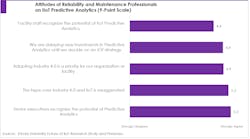The plant operator's perspective on predictive maintenance
A recent study on “The Future of IIoT Predictive Maintenance” was conducted by Emory University and
Presenso, designed to gain the perspective of plant-level employees on issues relating to deployment and the expected impact of IIoT PdM on plant operations.
We chatted with Eitan Vesely, CEO of Presenso, to get his insights. Take a look…
Smart Industry: How does the perception of digital transformation among the plant-floor staff differ from that of senior management?
Eitan: Although we deliberately did not interview executives for this report, there is a clear difference between plant-level employees and the senior management that I frequently encounter.
Senior management tends to be enthusiastic about the financial and operational potential of digital transformation. Plant-level employees have adopted a very pragmatic approach to IIoT, bordering on cynical. Most O&M professionals have not seen a compelling need for Industry 4.0 practices and expect change to be more incremental.
There is also an acknowledgement of the gap between expectations from plant employees and management. There was much stronger agreement with the notion that senior executives recognize the potential of predictive analytics relative to facility staff.
Smart Industry: How important is addressing that divide in terms of optimally adopting these new technologies?
Eitan: I don’t see the divide, per se, as preventing or delaying deployment. At the same time, given the fact that many industries are dealing with labor shortages, IIoT-based deployments cannot be mandated without providing sufficient resources.
In general, plant employees are more accepting of incremental change, such as the automation of workflows. If IIoT predictive maintenance simply provides new insights to trigger existing maintenance activities, then it will be adopted easily.
However, if plants need to hire data scientists and retrain O&M employees, then more resistance is likely. Ultimately, it’s a function of how IIoT PdM is defined and the extent to which tools are easy to understand and use.
Smart Industry: What is the level of satisfaction with current predictive-maintenance systems?
Eitan: Overall, most O&M professionals are satisfied with the status quo. Only 8% of survey respondents were very dissatisfied with current PdM systems and 16% somewhat dissatisfied. Change is coming from the top down with little input from plant workers.
Smart Industry: According to your study, what did you find to be the most common reasons for delays in investments in new IIoT predictive-maintenance solutions?
Eitan: The most common reason that was cited in both the online survey as well as interviews—the lack of labor resources, particularly data scientists.
Another factor cited was a lack of understanding of Industry 4.0.
What I found interesting is that there is less concern about the core infrastructure, sensor data and the complexity of software. Keep in mind that plant engineers are not trained in machine-learning. They recognize their limitations in this arena.
Smart Industry: What results in this study most surprised you? What results did you find encouraging?
Eitan: There was a surprising lack of awareness about emerging and new technologies. Most striking was that most O&M professionals (61%) were unfamiliar with the digital twin. Although I do encounter some skepticism about the digital twin from management, the solution is well known.
Ironically, the most encouraging insights could also be seen as a concern by some. O&M professionals have adopted a wait-and-see approach and are not getting swept up in the enthusiasm about Industry 4.0. O&M professionals should be commended on their realistic (but open-minded) approach to digital transformation, even when they are not part of the decision-making process. The stakes are high and before significant investments are made, the mature approach is to be conservative.
The full report is available here.








